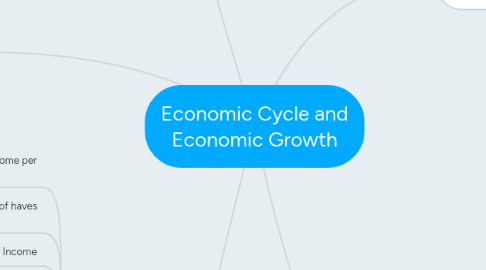
1. SSF Determine LR Growth
1.1. Education & Training
1.2. Levels of Infrastructure
1.3. Human Capital
1.4. Development of Technology
2. Economic Growth
2.1. Benefits
2.1.1. Government Finance
2.1.1.1. Tax Revenue
2.1.1.1.1. Employment and Income
2.1.2. Unemployment
2.1.2.1. Output
2.1.2.1.1. Demand for Labour
2.1.3. Poverty Reduction
2.1.3.1. Rising Income
2.1.4. Living Standards
2.1.5. Demand and Output
2.1.5.1. Investment in Capital
2.1.5.1.1. Machinery
2.2. Costs
2.2.1. Negative Externalities
2.2.1.1. Pollution and Congestion
2.2.1.1.1. Damage Social Welfare
2.2.2. Benefits not evenly distributed
2.2.3. Resource Depletion
2.2.4. Danger of Inflation
2.2.4.1. Value of Money
2.2.4.1.1. Demand Higher Wages
2.2.5. Urbanisation
2.2.5.1. Sallow up good agricultural land
3. Impact of Growth
3.1. Individuals
3.1.1. Trend in average income per head
3.1.2. A possible sharpening of haves and have-nots
3.1.3. Distribution of Income
3.1.4. Consumption Patterns
3.1.5. The Wealth Effect
3.1.5.1. Asset Prices in a Period of Growth
3.1.6. Choice of Jobs
3.1.7. Quality of Life
3.1.7.1. Human Development Index
3.1.7.2. Happiness Index
3.1.7.3. Misery Index
3.2. The Economy
3.2.1. Aggregate Demand
3.2.1.1. Changes to incentive to invest
3.2.1.1.1. Productive Capacity
3.2.1.2. The Balance of Payments On Current Account
3.2.1.3. Inwards/ Outwards FDI
3.2.2. Aggregate Supply
3.2.2.1. Inflation
3.2.3. Ability to sell overseas
3.2.3.1. Impacts on Exports
3.2.4. Employment/ Unemployment
3.2.5. World Growth
3.2.5.1. Changes to wealth creation in the UK
3.3. The Environment
3.3.1. Negative Externalities
3.3.1.1. Noise Pollution
3.3.1.2. Consumption of Demerit Goods
3.3.1.2.1. Damage Social Welfare
3.3.1.3. Lower Air Quality
3.3.1.3.1. Air Pollution
3.3.1.3.2. Road Congestion
3.3.1.4. Household and Industrial Waste
3.3.1.4.1. Reduce Social Welfare
4. Demand Side Shocks
4.1. Households/Corporate Spending
4.1.1. Changes in Unemployment
4.1.2. Changes in Saving
4.1.3. Changes in Confidence
4.1.4. Changes in Wages
4.1.5. Changes in Profits
4.2. Changes in Liquidity and Availability of Consumer and Business Credit
4.2.1. Financial Crisis raised the cost of credit (2008 Recession)
4.2.1.1. Interest Rates
4.3. Changes in Spending
4.3.1. Changes in House Prices
4.3.2. Changes in Share and Bond Prices
4.3.2.1. Wealth Effect
4.4. Investment Spending
4.4.1. Changes in Bankruptcies
4.4.2. Business Confidence
4.4.3. Profit Levels
4.5. Government Finance
4.5.1. Wars
4.5.2. Changes in Unemployment
4.6. Affects Planned Spending
4.6.1. Interest Rates
4.6.1.1. Consumers
4.6.1.2. Investment Spending
4.6.2. Tax Rates
4.6.3. Exchange Rates
4.6.3.1. Exports
4.6.3.2. Imports
5. Supply Side Shocks
5.1. Wage Levels
5.1.1. Firms Unit Labor Costs
5.2. Costs of Production
5.2.1. Commodity Prices
5.2.1.1. Oil Prices
5.3. Indirect Taxes
5.4. Subsidies
5.5. Productivity Factors
5.5.1. Labour
5.6. Use of Production Methods
5.7. Indirect Taxes
5.7.1. Income Tax
5.7.1.1. Disincentive/Incentive To Work

